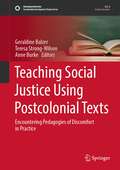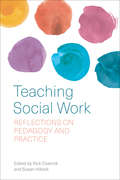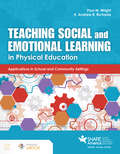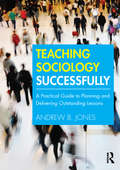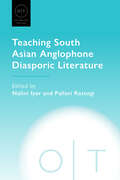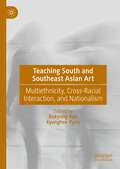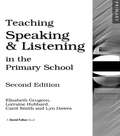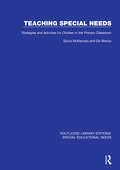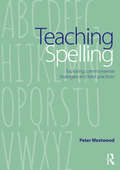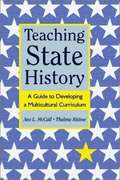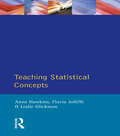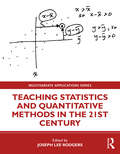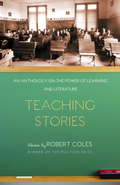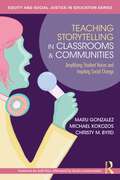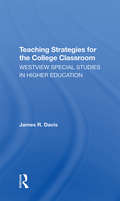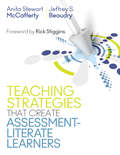- Table View
- List View
Teaching Social Justice Using Postcolonial Texts: Encountering Pedagogies of Discomfort in Practice (Sustainable Development Goals Series)
by Teresa Strong-Wilson Geraldine Balzer Anne BurkeThis book explores how teachers can re-examine their emotional investments in enacting dominant settler values through changing their text selection and teaching practices. Based on a longitudinal qualitative research study conducted by a national team of literacy scholars in collaboration with practicing literacy teachers at eight sites across Canada, the book investigates how groups of teachers, working collaboratively in inquiry groups, develop and implement curriculum to promote their own and their students’ understandings of social justice in postcolonial and settler spaces. In particular, the book highlights the rich and dynamic landscape of postcolonial authors, illustrators and texts, the development of culturally- sensitive curricula, and critical pedagogies possible in addressing contemporary and historical issues, both local and global. This book is primarily of interest to literacy scholars, literacy instructors (teacher educators) in teacher education programs, educational leaders, practicing teachers from the K-12 spectrum, and school district staff and policy makers with responsibilities for or interests in the potential of literacy and literature engagement for social justice education. The book is also be of interest to postsecondary educators and teacher educators wishing to use literature in social justice, anti-racist, and anti-oppressive courses.
Teaching Social Skills Through Sketch Comedy and Improv Games: A Social Theatre® Approach For Kids And Teens Including Those With Asd, Adhd, And Anxiety
by Shawn AmadorIntroducing a Social Theatre™, this book provides guidance on how to deliver fun and transformative activities to develop social skills in teenagers and children. Drawing on ideas from Social Thinking®, CBT, mindfulness and assertiveness training this book develops games, skits and short plays which can be adapted to suit children and teenagers including those who are gifted, typical, and those with mild to moderate cognitive abilities. These activities will help participants become more assertive and flexible as well as improving confidence, focus and self-esteem. Social Theatre™ can be used in small groups, in class or throughout the school, as well as in group therapy sessions. It provides a new and inclusive way to teach social skills and collaborative learning and is especially useful for those with anxiety, ADHD and ASD.
Teaching Social Skills to Students with Visual Impairments: From Theory to Practice
by Karen E. Wolffe Sharon Z. SacksHow do children become social beings? When a child is unable to observe visually and imitate how other people react and interact, this complex developmental process can become fragmented and incomplete. As a result, providing specific information, direct instruction, and opportunities for social interaction to children who are blind or visually impaired is critical to their growth and education. Edited by two groundbreaking educators and researchers, with contributions from other outstanding educators and researchers in this area, Teaching Social Skills to Students with Visual Impairments explores what theory can tell us about how children who are visually impaired become socially skilled individuals. It then presents a compendium of techniques and strategies for helping youngsters, from preschoolers through young adults, including those with additional disabilities, develop and refine social skills.
Teaching Social Studies to English Language Learners
by Stephen J. Thornton Bárbara C. CruzTeaching Social Studies to English Language Learners provides readers with a comprehensive understanding of both the challenges that face English language learners (ELLs) and ways in which educators might address them in the social studies classroom. The authors offer context-specific strategies for the full range of the social studies curriculum, including geography, U.S. history, world history, economics, and government. These practical instructional strategies will effectively engage learners and can be incorporated as a regular part of instruction in any classroom. An annotated list of web and print resources completes the volume, making this a valuable reference to help social studies teachers meet the challenges of including all learners in effective instruction. Features and updates to this new edition include: • An updated and streamlined Part 1 provides an essential overview of ELL theory in a social studies specific-context. • "Teaching Tips" offer helpful suggestions and ideas for creating and modifying lesson plans to be inclusive of ELLs. • Additional practical examples and new pedagogical elements in Part 3 include more visuals, suggestions for harnessing new technologies, discussion questions, and reflection points. • New material that takes into account the demands of the Common Core State Standards, as well as updates to the web and print resources in Part 4.
Teaching Social Studies to English Language Learners (Teaching English Language Learners across the Curriculum)
by Stephen J. Thornton Bárbara C. CruzThis fully updated new edition provides readers with a comprehensive understanding of the challenges that English language learners (ELLs), also known as English Learners (ELs), face, as well as the ways in which educators might address them in the social studies classroom.The authors offer context-specific strategies for the full range of the social studies curriculum, including geography, U.S. history, world history, economics, and government. These practical instructional strategies will effectively engage learners and can be incorporated as a regular part of instruction in any classroom. Features of this fully updated new edition include:· An updated and streamlined introduction, which provides an essential overview of ELL theory in a social studies-specific context;· "Teaching Tips" that offer helpful suggestions and ideas for creating and modifying lesson plans to be inclusive of English Learners;· Practical examples and pedagogical elements in Part 3, which include more visuals, suggestions for harnessing new technologies, discussion questions, and reflection points; and· Useful lists of online and print resources for teachers and students.Teaching Social Studies to English Language Learners is a valuable reference to help pre- and in-service social studies educators meet the challenges of including all learners in effective instruction.
Teaching Social Work: Reflections on Pedagogy and Practice
by Rick Csiernik Susan HillockSocial work education has the potential to be transformative, consciousness raising, and to produce social change while inspiring hope in students for the creation of more just systems. An understanding of oppression, its diverse manifestations, and its differential impact on vulnerable individuals and groups is essential to contemporary social work education. What then is the best manner in which to prepare educators for the immensely important, complex, and multidimensional role as teacher of social work? Most social work instructors learn to teach through trial and error, bringing their own style, experiences, and preferences to the endeavour rather than having a formal program of education and instruction on how to best educate and instruct. This book addresses the complex and uncertain field of social work education, gathering together thirty experienced professors and practitioners who teach in BSW, MSW, and PhD programs. Together, the contributors create a framework for social work educators to reflect on how they teach, why they teach in specific ways, and what works best for teaching in the discipline of social work.
Teaching Social and Emotional Learning in Physical Education: Applications In School And Community Settings
by K. Andrew Richards Paul M WrightTeaching Social and Emotional Learning in Physical Education is the ideal resource for understanding and integrating social and emotional learning (SEL) competencies into the structure of a physical education program, alongside physical activity and skill development goals. This text should be incorporated as a key resource to guide physical education teacher education courses specifically focused on social and emotional learning while also providing supplemental readings for courses related to physical education curriculum, instruction, assessment, and/or models-based practice. Similarly, practicing physical education teachers who are interested in developing a stronger focus on SEL in their teaching will find that the book provides a comprehensive resource to guide their professional learning and practice.
Teaching Sociology Successfully: A Practical Guide to Planning and Delivering Outstanding Lessons
by Andrew B. JonesTeaching Sociology Successfully is a comprehensive guide to teaching, learning and delivering sociology, not only with success but with confidence. Carefully combing insightful anecdotes and practical ideas with key theoretical concepts on planning, learning styles and assessment, this book is an essential tool for both new and experienced teachers of sociology. Each chapter focuses on a particular aspect of the teaching and learning process – from preparing to teach the subject for the first time to measuring student progress over time – in an approachable yet rigorous way. This practical guide will help you to: improve your knowledge of specifications and syllabuses at GCSE and AS/A Level; provide the best pedagogic approaches for teaching sociology; think about learning styles, skills and capacities in relation to teaching sociology; gain practical ideas and activities for improving student’s argumentation, evaluation and essay writing skills; apply strategies for teaching abstract sociological theories and concepts; make the teaching of research methods engaging and interesting; deal with practical issues such as planning and assessing learning; encourage students’ independent learning and revision; connect ICT, social networking websites and the mass media to further students’ sociological knowledge; tackle the thorny issues of politics and controversial topics. Drawing on the author’s own experiences, Teaching Sociology Successfully helps readers to identify, unpack and negotiate challenges common to those teaching sociology. Complete with a variety of pedagogical resources, it provides tasks and further reading to support CPD and reflective practice. This book will be an invaluable tool for students on PGCE social science training courses, as well as School Direct candidates and undergraduates studying BEds in similar fields.
Teaching South Asian Anglophone Diasporic Literature (Options for Teaching)
by Nalini Iyer and Pallavi RastogiMigration from the Indian subcontinent began on a large scale over 150 years ago, and today there are diasporic communities around the world. The identities of South Asians in the diaspora are informed by roots in the subcontinent and the complex experiences of race, religion, nation, class, caste, gender, sexuality, language, trauma, and geography. The literature that arises from these roots and experiences is diverse, powerful, and urgent.Teaching South Asian Anglophone Diasporic Literature embraces an intersectionality that attends to the historical and material conditions of cultural production, the institutional contexts of pedagogy, and the subject positions of teachers and students. Encouraging a deep engagement with works whose personal, political, and cultural insights are specific to South Asian diasporic consciousness, the volume also provokes meaningful reflection on other literatures in an age of increasing migration and diaspora.
Teaching South and Southeast Asian Art: Multiethnicity, Cross-Racial Interaction, and Nationalism
by Kyunghee Pyun Bokyung KimThis volume challenges existing notions of what is “Indian,” “Southeast Asian,” and/or “South Asian” art to help educators present a more contextualized understanding of art in a globalized world. In doing so, it (re)examines how South or Southeast Asian art is being made, exhibited, circulated and experienced in new ways in the United States or in regions under its cultural hegemony. The essays presented in this book examine both historical and contemporary transformations or lived experiences of monuments and regional styles (sites) from South or Southeast Asian art in art making, subsequent usage, and exhibition-making under the rubric of “Indian,” “South Asian,” “or “Southeast Asian” Art.
Teaching Speaking and Listening in the Primary School
by Carol Smith Lyn Dawes Elizabeth Grugeon Lorraine HubbardThis newly revised second edition looks at ways in which teachers can develop children's abilities in speaking and listening, as required by the National Curriculum. The authors discuss the links between language and learning; offer case studies and suggestions for classroom practice; and provide stimulating activities to help pupils to become more articulate, coherent and effective in standard English. The book is a suitable text for students taking primary initial teacher training courses. It will also be welcomed as a practical handbook for primary teachers.
Teaching Speaking and Listening in the Primary School
by Carol Smith Lyn Dawes Elizabeth Grugeon Lorraine HubbardSpeaking and listening, along with reading and writing, are essential components of literacy and learning development within the National Primary Strategy. This best-selling introductory text updates teachers on national developments and best practice in speaking and listening in the classroom through: speaking and listening issues: a review story-telling and drama oral and popular culture and media planning for talk across the curriculum the impact of ICT: software, email, internet, computer games.
Teaching Special Needs: Strategies and Activities for Children in the Primary Classroom (Routledge Library Editions: Special Educational Needs #37)
by Sylvia McNamara Gill BlencoFirst published in 1993.This book is about teaching Children with Special Needs in mainstream primary classroom. Normal practice was, and often still is, to remove children who find it difficult to learn in the classroom environment and teacher them in small groups elsewhere. This damages their self-esteem and impacts negatively on their ability to learn. Out premise that it is better to change the classroom so that all children can be successful learners within it. It takes the view that it is beneficial for all children to learn to be helpers of each other within the classroom and for all children to be helped. The book offers a range of strategies including teaching the children skills for working in a pair and how to use structured group work to deliver any curriculum. This has developed into an approach called Talk for Learning which is applicable to all children and all ages of learners.
Teaching Spelling: Exploring commonsense strategies and best practices
by Peter WestwoodTeaching Spelling: Exploring commonsense strategies and best practices equips teachers with the vital knowledge and skills needed to help their students become proficient writers and spellers. Peter Westwood provides a very clear and concise account of the important skills and processes that underpin accurate spelling, and describes in very practical terms, many evidence-based strategies and methods that teachers can use to help all students become confident, capable and independent spellers. The book also addresses the purposes of various forms of assessment of spelling skills, to guide teaching and planning. Chapters in this accessible and timely text include: the importance of correct spelling visual, auditory and cognitive components of spelling ability general principles for planning instruction proven teaching strategies and methods word study as a teaching approach formal and informal assessment At the end of each chapter the author provides a list of online and print resources, thus enabling readers to extend their knowledge in the various topics. The extensive reference list is also an invaluable source of information on recent research and thinking on the topic of spelling instruction. Teaching Spelling: Exploring commonsense strategies and best practices is an essential resource for all those in teacher education and taking in-service courses.
Teaching Sprints: How Overloaded Educators Can Keep Getting Better
by Simon Breakspear Bronwyn Ryrie JonesEnhance teachers’ expertise – in every term, every school year. With all of the everyday demands of teaching, the job of improving classroom practice is a challenge for teachers and school leaders. Grounded by research and field-tested around the world, Teaching Sprints offers a professional improvement process that works in theory and practice. Including insights from the field, and practical protocols, this book outlines a simple model for engaging in short bursts of evidence-informed improvement work. Using Teaching Sprints, teams of teachers can enhance their expertise together, in a way that is sustainable on the ground. In Teaching Sprints, readers will find: three big ideas about practice improvement a detailed description of a simple improvement process advice on how to establish a routine for continual improvement Whether you’re a classroom teacher thinking about your own practice, an instructional leader supporting colleagues to teach better tomorrow, or a school leader interested in enhancing your program for professional learning, Teaching Sprints is a must-read for you. "Among the greatest unresolved issues within schools is developing great models of implementation: Sprints is certainly one of the breakthroughs. This book can make major improvements in schools and classrooms, ironically by focusing on tiny shifts." John Hattie, Laureate Professor Melbourne Graduate School of Education Melbourne, Australia "Once in a while you come across a book that really cuts through the complexity of issues and provides a refreshing and practical approach to improving what happens in schools. This is such a book. Evidence-based, easy to read and full of down-to-earth ideas that busy teachers can implement. I love it." Steve Munby, Visiting Professor University College London Former CEO, National College for School Leadership London, UK
Teaching Sprints: How Overloaded Educators Can Keep Getting Better
by Simon Breakspear Bronwyn Ryrie JonesEnhance teachers’ expertise – in every term, every school year. With all of the everyday demands of teaching, the job of improving classroom practice is a challenge for teachers and school leaders. Grounded by research and field-tested around the world, Teaching Sprints offers a professional improvement process that works in theory and practice. Including insights from the field, and practical protocols, this book outlines a simple model for engaging in short bursts of evidence-informed improvement work. Using Teaching Sprints, teams of teachers can enhance their expertise together, in a way that is sustainable on the ground. In Teaching Sprints, readers will find: three big ideas about practice improvement a detailed description of a simple improvement process advice on how to establish a routine for continual improvement Whether you’re a classroom teacher thinking about your own practice, an instructional leader supporting colleagues to teach better tomorrow, or a school leader interested in enhancing your program for professional learning, Teaching Sprints is a must-read for you. "Among the greatest unresolved issues within schools is developing great models of implementation: Sprints is certainly one of the breakthroughs. This book can make major improvements in schools and classrooms, ironically by focusing on tiny shifts." John Hattie, Laureate Professor Melbourne Graduate School of Education Melbourne, Australia "Once in a while you come across a book that really cuts through the complexity of issues and provides a refreshing and practical approach to improving what happens in schools. This is such a book. Evidence-based, easy to read and full of down-to-earth ideas that busy teachers can implement. I love it." Steve Munby, Visiting Professor University College London Former CEO, National College for School Leadership London, UK
Teaching State History: A Guide to Developing a Multicultural Curriculum
by Ava L. Mccall Thelma RistowThe text offers specific examples of the curricular framework in action, portraying teaching strategies and students' responses to topics that range from the process of becoming a state, the first inhabitants of the state, state government, state industries, and family histories to even more challenging subjects including treaties with Native Americans and the struggle for voting rights.
Teaching Statistical Concepts (Effective Teacher, The)
by Anne Hawkins Flavia Jolliffe Leslie GlickmanThere is growing recognition that statistics should be part of the core curriculum for the compulsory schooling of all children, leading to a now urgent need for teachers to be trained in both statistical content and appropriate teaching methods. This book lays the foundation for teacher's responses to these changes, exploring how best to teach those applied skills which are now seen to be a more relevant part of the content of statistical courses.
Teaching Statistics and Quantitative Methods in the 21st Century (Multivariate Applications Series)
by Joseph Lee RodgersThis work, which provides a guide for revising and expanding statistical and quantitative methods pedagogy, is useful for novice and seasoned instructors at both undergraduate and graduate levels, inspiring them to use transformative approaches to train students as future researchers. Is it time for a radical revision in our pedagogical orientation? How are we currently teaching introductory statistics and quantitative methods, and how should we teach them? What innovations are used, what is in development? This ground-breaking edited volume addresses these questions and more, providing cutting-edge guidance from highly accomplished teachers. Many current textbooks and syllabi differ in only superficial ways from those used 50 years ago, yet the field of quantitative methods—and its relationship to the research enterprise—has expanded in many important ways. A philosophical axiom underlying this book is that introductory teaching should prepare students to potentially enter more advanced quantitative methods training and ultimately to become accomplished researchers. The reader is introduced to classroom innovation, and to both pragmatic and philosophical challenges to the status quo, motivating a broad revolution in how introductory statistics and quantitative methods are taught. Designed to update and renovate statistical pedagogy, this material will stimulate students, new instructors, and experienced teachers.
Teaching Statistics in School Mathematics-Challenges for Teaching and Teacher Education
by Gail Burrill Carmen Batanero Chris ReadingTeaching Statistics in School Mathematics-Challenges for Teaching and Teacher Education results from the Joint ICMI/IASE Study Teaching Statistics in School Mathematics: Challenges for Teaching and Teacher Education. Oriented to analyse the teaching of statistics in school and to recommend improvements in the training of mathematics teachers to encourage success in preparing statistically literate students, the volume provides a picture of the current situation in both the teaching of school statistics and the pre-service education of mathematics teachers. A primary goal of Teaching Statistics in School Mathematics-Challenges for Teaching and Teacher Education is to describe the essential elements of statistics, teacher's professional knowledge and their learning experiences. Moreover, a research agenda that invites new research, while building from current knowledge, is developed. Recommendations about strategies and materials, available to train prospective teachers in university and in-service teachers who have not been adequately prepared, are also accessible to the reader.
Teaching Stories
by Judy LoganWhen nearly everyone else is telling kids no—"No, do it this way….No, I don’t want to hear what you think….No, sit down and pay attention"—Judy Logan says yes, to a child’s passions, interests, and hopes. The results have been news-making; her students blossom academically, winning essay contests, prizes, and entrance to the country’s best colleges. Armed with a strong sense of who they are and what they think, her students also blossom personally—resisting peer pressure, understanding racial and gender stereotypes, and connecting to the world in which they live.Drawing on over thirty years "knee deep in adolescence" as a teacher in a public middle school, Judy Logan shows that it is the very vulnerability of adolescence that makes it a time of tremendous opportunity for emotional, intellectual, and social growth. Uniting creativity and compassion, Logan’s vivid classroom stories bring into focus for all parents numerous effective strategies for working with adolescents.Above all, Judy Logan is a compelling storyteller who loves and respects her students and the work of learning. Eye-opening and inspirational, the stories she has to tell take the simple human drama of day-to-day classroom life and create an all-embracing vision of the possibilities of public education in America.
Teaching Stories
by Robert ColesThe Call of Stories presents a study of how listening to stories promotes learning and self-discovery. Copyright © Libri GmbH. All rights reserved.
Teaching Storytelling in Classrooms and Communities: Amplifying Student Voices and Inspiring Social Change (Equity and Social Justice in Education Series)
by Maru Gonzalez Michael Kokozos Christy M. ByrdUnleash the transformative power of storytelling to build belonging, ignite critical consciousness, and amplify students’ voices. This dynamic book equips educators who work with middle and high school aged youth to teach storytelling in their classrooms or community organizations.Through inspiring examples and hands-on teaching strategies, the authors show you how to build trust and foster community, explore diverse storytelling modes and formats, guide students in developing effective and ethical social impact stories, and more. You’ll also discover practical tools to help students broaden their story’s reach and impact through collaboration and coalition building. Each chapter brims with student examples, ready-to-use teaching tips, and experiential activities, plus questions designed to spark dialogue and help students awaken and embrace the storyteller within. There are also reflective prompts to support your own journey as both a facilitator and participant in the storytelling exchange.Packed with practical resources, moving narratives, and actionable tips, this book is your essential guide to cultivating a supportive learning community, increasing student engagement, and unlocking young people’s leadership potential through the vehicle of storytelling.
Teaching Strategies For The College Classroom
by James Davis"Another book on college teaching?" you may ask. "Surely too many have been written already!" Dr Davis hopes that professors with find this to be a different book on college teaching, because it explores in depth some viable teaching strategies for the college classroom. This book has grown out of a course on college teaching offered regularly at the University of Denver.
Teaching Strategies That Create Assessment-Literate Learners
by Jeffrey S. Beaudry Anita Stewart McCaffertyYour go-to guide for using classroom assessment as a teaching and learning tool! How can we bring students into the assessment process as full partners in ways that help them become owners of learning? Becoming an assessment-literate learner means understanding where you are going as a learner, where you’re at now, and what you need to do to reach a learning goal. This book unpacks seven strategies of assessment for learning, along with the five keys of quality assessment, in a practical vision of quality assessment used to support and certify learning. With a focus on high-impact classroom practices, this book offers Clear and relevant examples of assessment for learning strategies in specific subject matter contexts Visual learning progressions for use in a self-assessment checklist and professional development Additional material and examples on an author-created website When we take a balanced approach to assessment and give students the tools and skills to support their own progress, students and teachers win. This book gives you the strategies and examples to make this possible. "This is the book that practitioners have been waiting for: Assessment kept simple—its importance and how to do it, with plenty of support and templates to ensure success." —Ken Darvall, Principal Tema International School
